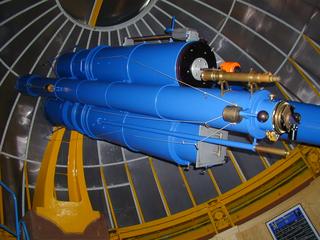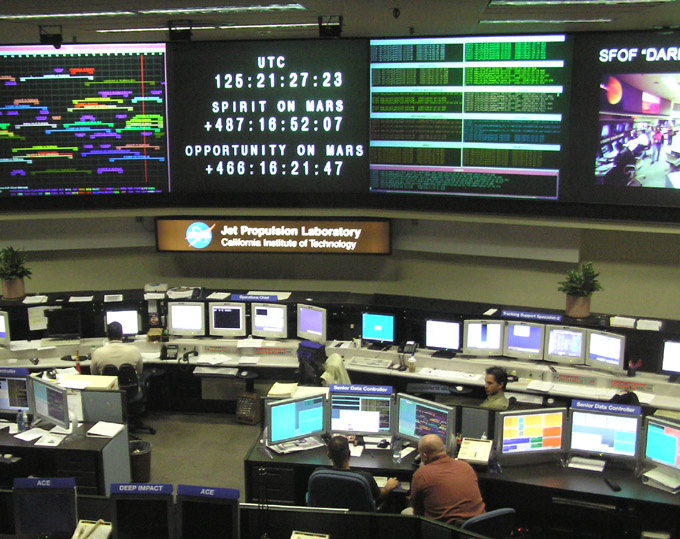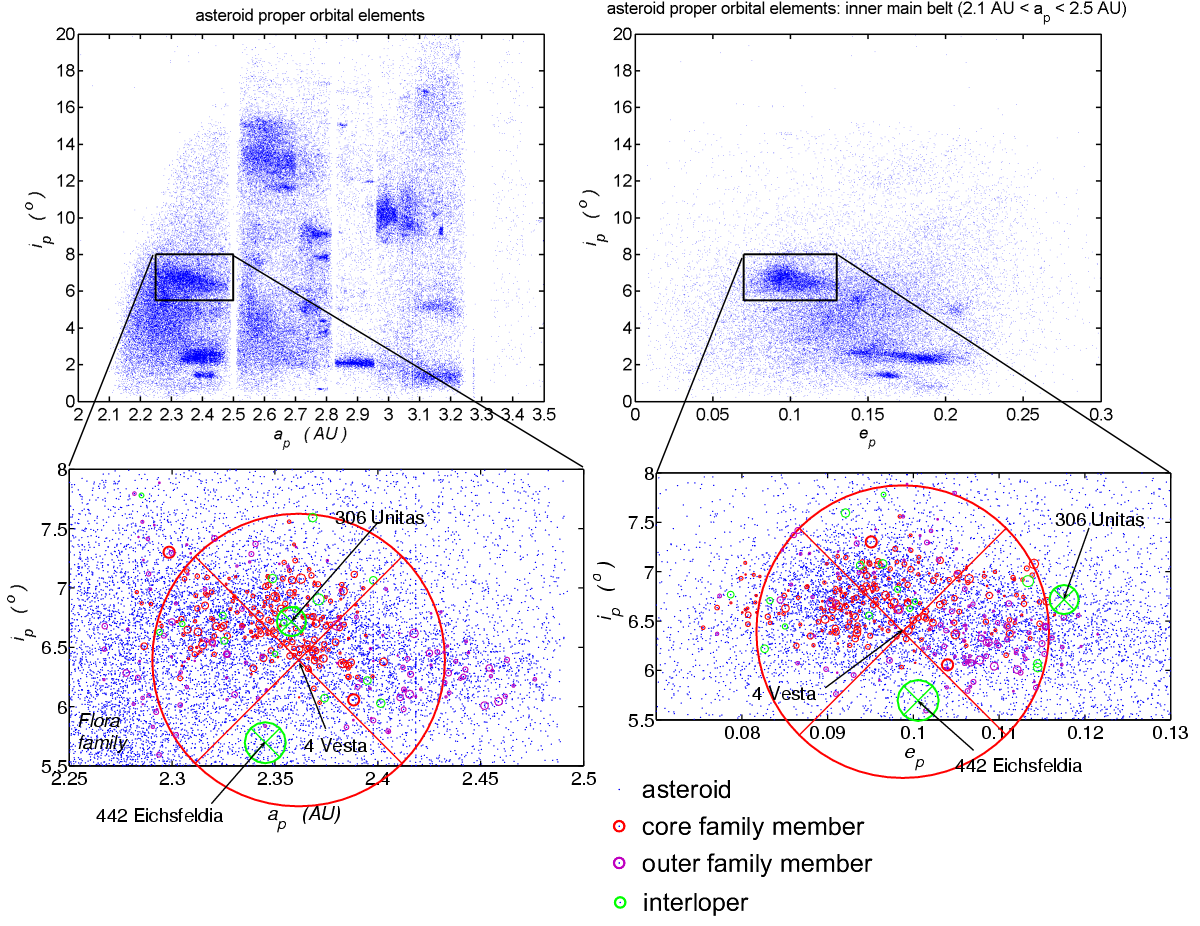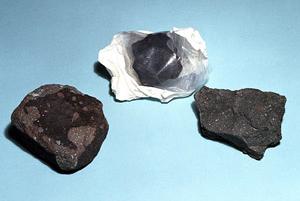|
442 Eichsfeldia
Eichsfeldia (minor planet designation: 442 Eichsfeldia) is a large main belt asteroid that was discovered by German astronomers Max Wolf and A. Schwassmann on 15 February 1899 in Heidelberg. It is classified as a C-type asteroid and is probably composed of primitive carbonaceous material. Although Eichsfeldia has an orbit similar to the Vesta family asteroids, it was found to be an unrelated interloper on the basis of its non-matching spectral type In astronomy, stellar classification is the classification of stars based on their spectral characteristics. Electromagnetic radiation from the star is analyzed by splitting it with a prism or diffraction grating into a spectrum exhibiting th .... References External links Lightcurve plot of (442) Eichsfeldia Antelope Hills Observatory * * 000442 Discoveries by Max Wolf Discoveries by Friedrich Karl Arnold Schwassmann Named minor planets 000442 000442 18990215 {{C-beltasteroid-stub ... [...More Info...] [...Related Items...] OR: [Wikipedia] [Google] [Baidu] |
Max Wolf
Maximilian Franz Joseph Cornelius Wolf (21 June 1863 – 3 October 1932) was a German astronomer and a pioneer in the field of astrophotography. He was the chairman of astronomy at the University of Heidelberg and director of the Heidelberg-Königstuhl State Observatory from 1902 until his death in 1932. Early life Max Wolf was born in Heidelberg, Germany on 21 June 1863, the son of medical doctor Franz Wolf. His father encouraged an interest in science and built an observatory for his son in the garden of the family home. It is from here that Wolf was credited with his first astronomical discovery, comet 14P/Wolf, in 1884. Life at the university Wolf attended his local university and, in 1888, at the age of 25, was awarded a Ph.D. by the University of Heidelberg. He spent one year of post-graduate study in Stockholm, the only significant time he would spend outside of Heidelberg in his life. He returned to the University of Heidelberg and accepted the position of ' ... [...More Info...] [...Related Items...] OR: [Wikipedia] [Google] [Baidu] |
Heidelberg
Heidelberg (; Palatine German language, Palatine German: ''Heidlberg'') is a city in the States of Germany, German state of Baden-Württemberg, situated on the river Neckar in south-west Germany. As of the 2016 census, its population was 159,914, of which roughly a quarter consisted of students. Located about south of Frankfurt, Heidelberg is the List of cities in Baden-Württemberg by population, fifth-largest city in Baden-Württemberg. Heidelberg is part of the densely populated Rhine-Neckar, Rhine-Neckar Metropolitan Region. Heidelberg University, founded in 1386, is Germany's oldest and one of Europe's most reputable universities. Heidelberg is a Science, scientific hub in Germany and home to several internationally renowned #Research, research facilities adjacent to its university, including the European Molecular Biology Laboratory and four Max Planck Society, Max Planck Institutes. The city has also been a hub for the arts, especially literature, throughout the centurie ... [...More Info...] [...Related Items...] OR: [Wikipedia] [Google] [Baidu] |
C-type Asteroids (Tholen)
C-type (carbonaceous) asteroids are the most common variety, forming around 75% of known asteroids. They are volatile-rich and distinguished by a very low albedo because their composition includes a large amount of carbon, in addition to rocks and minerals. Their density averages at about . They occur most frequently at the outer edge of the asteroid belt, 3.5 astronomical units (AU) from the Sun, where 80% of the asteroids are of this type, whereas only 40% of asteroids at 2 AU from the Sun are C-type. The proportion of C-types may actually be greater than this, because C-types are much darker (and therefore less detectable) than most other asteroid types except for D-types and others that are mostly at the extreme outer edge of the asteroid belt. Characteristics Asteroids of this class have spectra very similar to those of carbonaceous chondrite meteorites (types CI and CM). The latter are very close in chemical composition to the Sun and the primitive solar nebula minu ... [...More Info...] [...Related Items...] OR: [Wikipedia] [Google] [Baidu] |
Named Minor Planets
Named may refer to something that has been given a name. Named may also refer to: * named (computing), a widely used DNS server * Naming (parliamentary procedure) Naming is a procedure in some Westminster parliaments that provides for the speaker to temporarily remove a member of parliament who is breaking the rules of conduct of the legislature. Historically, "naming" refers to the speaker's invocation of ... * The Named (band), an American industrial metal group In literature: * '' The Named'', a fantasy novel by Marianne Curley * The Named, a fictional race of prehistoric big cats, depicted in '' The Books of the Named'' series by Clare Bell See also * Name (other) * Names (other) * Naming (other) {{disambiguation ... [...More Info...] [...Related Items...] OR: [Wikipedia] [Google] [Baidu] |
Discoveries By Friedrich Karl Arnold Schwassmann
Discoveries may refer to: Music * ''Discoveries'' (Cannonball Adderley album), 1955 * ''Discoveries'' (Josh Nelson album), 2011 * ''Discoveries'' (Northlane album), 2011 Other uses * ''Discoveries'' (film), a 1939 British film * Discoveries (horse), a racehorse * ''Discoveries'' (Robertson Davies), a 2002 book by Robertson Davies * ''Discoveries'' (TV series), a Canadian youth science television series which aired on CBC Television in 1957 * ''Abrams Discoveries'', a series of illustrated non-fiction books published by Harry N. Abrams * ''Discoveries'', a work by William Butler Yeats, written in 1907 * ''Discoveries'', a magazine published by Cedars-Sinai Medical Center See also * Age of Discoveries * Discovery (other) Discovery may refer to: * Discovery (observation), observing or finding something unknown * Discovery (fiction), a character's learning something unknown * Discovery (law), a process in courts of law relating to evidence Discovery, The Disco ... [...More Info...] [...Related Items...] OR: [Wikipedia] [Google] [Baidu] |
Background Asteroids
Background may refer to: Performing arts and stagecraft * Background actor * Background artist * Background light * Background music * Background story * Background vocals * ''Background'' (play), a 1950 play by Warren Chetham-Strode Recorded works * ''Background'' (1953 film), a British drama * ''Background'' (1973 film), a documentary * ''Background'' (TV series), a Canadian journalistic television series * ''Background'' (Lifetime album), 1992 * ''Background'' (Bassi Maestro album), 2002 Science and engineering * Background extinction rate * Background independence, a condition in theoretical physics * Background noise * Background radiation, the natural radiation that is always present in a location ** Background (astronomy), small amounts of light coming from otherwise dark parts of the sky ** Cosmic background (other) ** Gravitational wave background ** X-ray background * Background process, software that is running but not being displayed * ... [...More Info...] [...Related Items...] OR: [Wikipedia] [Google] [Baidu] |
Jet Propulsion Laboratory
The Jet Propulsion Laboratory (JPL) is a federally funded research and development center and NASA field center in the City of La Cañada Flintridge, California, United States. Founded in the 1930s by Caltech researchers, JPL is owned by NASA and managed by the nearby California Institute of Technology (Caltech). The laboratory's primary function is the construction and operation of planetary robotic spacecraft, though it also conducts Earth-orbit and astronomy missions. It is also responsible for operating the NASA Deep Space Network. Among the laboratory's major active projects are the Mars 2020 mission, which includes the '' Perseverance'' rover and the '' Ingenuity'' Mars helicopter; the Mars Science Laboratory mission, including the '' Curiosity'' rover; the InSight lander (''Interior Exploration using Seismic Investigations, Geodesy and Heat Transport''); the ''Mars Reconnaissance Orbiter''; the '' Juno'' spacecraft orbiting Jupiter; the '' SMAP'' satellite for earth ... [...More Info...] [...Related Items...] OR: [Wikipedia] [Google] [Baidu] |
Asteroid Spectral Types
An asteroid spectral type is assigned to asteroids based on their emission spectrum, color, and sometimes albedo. These types are thought to correspond to an asteroid's surface composition. For small bodies that are not internally differentiated, the surface and internal compositions are presumably similar, while large bodies such as Ceres and Vesta are known to have internal structure. Over the years, there has been a number of surveys that resulted in a set of different taxonomic systems such as the Tholen, SMASS and Bus–DeMeo classifications. Taxonomic systems In 1975, astronomers Clark R. Chapman, David Morrison, and Ben Zellner developed a simple taxonomic system for asteroids based on color, albedo, and spectral shape. The three categories were labelled " C" for dark carbonaceous objects, " S" for stony (silicaceous) objects, and "U" for those that did not fit into either C or S. This basic division of asteroid spectra has since been expanded and clarified.Thomas ... [...More Info...] [...Related Items...] OR: [Wikipedia] [Google] [Baidu] |
Interloper (asteroid)
An asteroid family is a population of asteroids that share similar proper orbital elements, such as semimajor axis, eccentricity, and orbital inclination. The members of the families are thought to be fragments of past asteroid collisions. An asteroid family is a more specific term than asteroid group whose members, while sharing some broad orbital characteristics, may be otherwise unrelated to each other. General properties Large prominent families contain several hundred recognized asteroids (and many more smaller objects which may be either not-yet-analyzed, or not-yet-discovered). Small, compact families may have only about ten identified members. About 33% to 35% of asteroids in the main belt are family members. There are about 20 to 30 reliably recognized families, with several tens of less certain groupings. Most asteroid families are found in the main asteroid belt, although several family-like groups such as the Pallas family, Hungaria family, and the Phocaea fa ... [...More Info...] [...Related Items...] OR: [Wikipedia] [Google] [Baidu] |
Vesta Family
The Vesta family (adj. ''Vestian''; ) is a family of asteroids. The cratering family is located in the inner asteroid belt in the vicinity of its namesake and principal body, 4 Vesta. It is one of the largest asteroid families with more than 15,000 known members and consists of mostly bright V-type asteroids, so-called "vestoids". Characteristics The Vestian asteroids consist of 4 Vesta, the second-most-massive of all asteroids (mean diameter of 530 km), and many small asteroids below 10 km diameter. The brightest of these, 1929 Kollaa and 2045 Peking, have an absolute magnitude of 12.2, which would give them a radius of about 7.5 km assuming the same high albedo as 4 Vesta. The family originated from an impact on asteroid 4 Vesta, with the giant south-polar crater the likely impact site. The family are thought to be the source of the HED meteorites. The Vesta family also includes a few J-type asteroids (related to the V-type), which are thought to hav ... [...More Info...] [...Related Items...] OR: [Wikipedia] [Google] [Baidu] |
Carbonaceous Chondrite
Carbonaceous chondrites or C chondrites are a class of chondritic meteorites comprising at least 8 known groups and many ungrouped meteorites. They include some of the most primitive known meteorites. The C chondrites represent only a small proportion (4.6%) of meteorite falls. Some famous carbonaceous chondrites are: Allende, Murchison, Orgueil, Ivuna, Murray, Tagish Lake, Sutter's Mill and Winchcombe. General description C chondrites contain a high proportion of carbon (up to 3%), which is in the form of graphite, carbonates and organic compounds, including amino acids. In addition, they contain water and minerals that have been modified by the influence of water. The carbonaceous chondrites were not exposed to higher temperatures, so that they are hardly changed by thermal processes. Some carbonaceous chondrites, such as the Allende meteorite, contain calcium-aluminum-rich inclusions (CAIs). These are compounds that emerged early from the primeval solar nebula, c ... [...More Info...] [...Related Items...] OR: [Wikipedia] [Google] [Baidu] |





